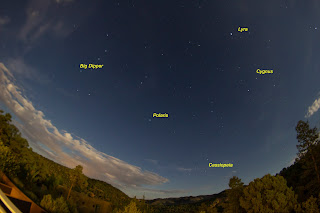There is a lot of detail visible in this image which is surprising since it was taken with a 200mm camera lens rather than a telescope. I wanted to test out the portability of my portable setup in an actual situation rather than just setting up at my house which I have been doing. The object itself was unplanned, meaning I did not know I would image this until I got there, however, the only other object I was thinking about was the nearby Eagle and Omega complex. It was visible for approximately 2.500 hours at this location but I was only to get about 1.5 hours - not a lot but enough to get a decent image. The portable setup works really well and the only issue I had was trying to find the Lagoon as the iOptron SkyGuider Pro is not go-to so I had to locate the object the old fashion way. The main thing I tested this night which I have not before was powering it in the field. For my other mounts and setups I use a Deep Cycle Marine battery to power the scopes, camera, dew heaters, computer, and etc. For this setup, the SkyGuider has its own power, there is no computer as the ASIAIR is controlled by a tablet. To power the camera and ASIAIR I used Maxoak K2 Laptop Power Bank ($129 Amazon) which still had plenty of power after I was done as did the SkyGuider - both of these would have worked for the entire night.
https://www.instagram.com/astroquest1/
http://astroquest1.blogspot.com/
https://www.astrobin.com/users/kurtzepp/collections/
http://youtube.com/c/AstroQuest1
http://astroquest1.blogspot.com/
https://www.astrobin.com/users/kurtzepp/collections/
http://youtube.com/c/AstroQuest1
Dates: 7-3
Camera: ZWO ASI2600MC-Pro
Telescope: Canon EF 200mm f/2.8L II USM Lens
Barlow: None
Focal Length: 200mm
f/4 with stepdown rings
Focal Reducer: None
Mount: iOptron SkyGuider Pro
Filter Wheel/Drawer: ZWO EOS Filter Drawer
Filter: IDAS NBZ
Focuser: None
Autoguiding: ASI120 Mini attached to a ZWO Mini 30/120mm Guidescope
Exposure: 41 x 120
Gain: 100
Sensor Temp: 0 C
Processing: NINA, PixInsight, Photoshop, StarXTerminator.
Power: Maxoak K2 Laptop Power Bank
https://www.instagram.com/astroquest1/
http://astroquest1.blogspot.com/
https://www.astrobin.com/users/kurtzepp/collections/
http://youtube.com/c/AstroQuest1











